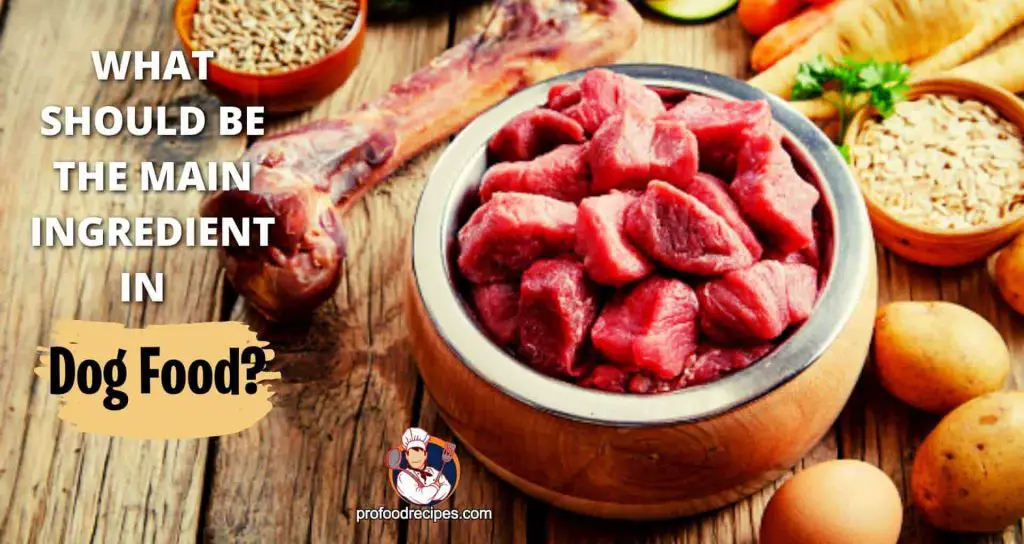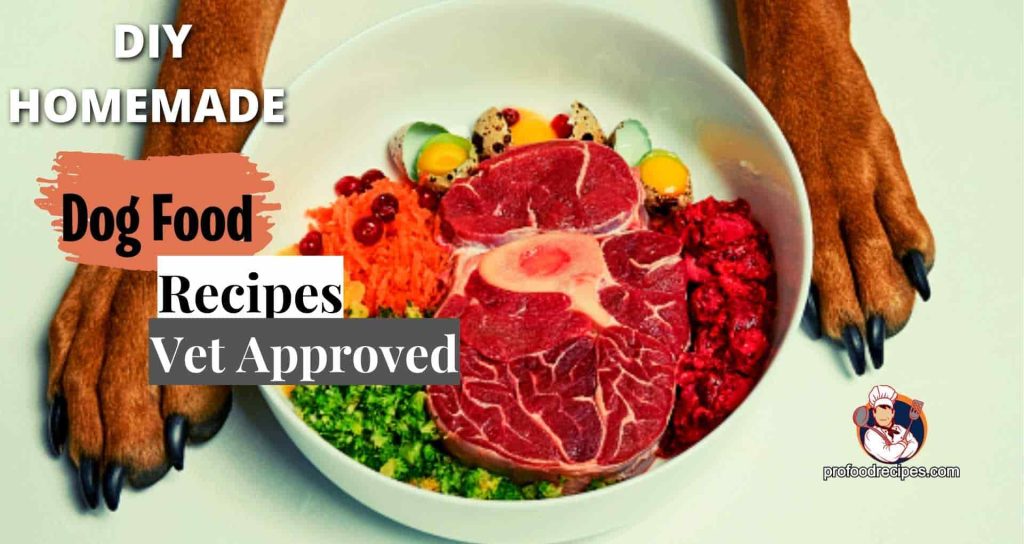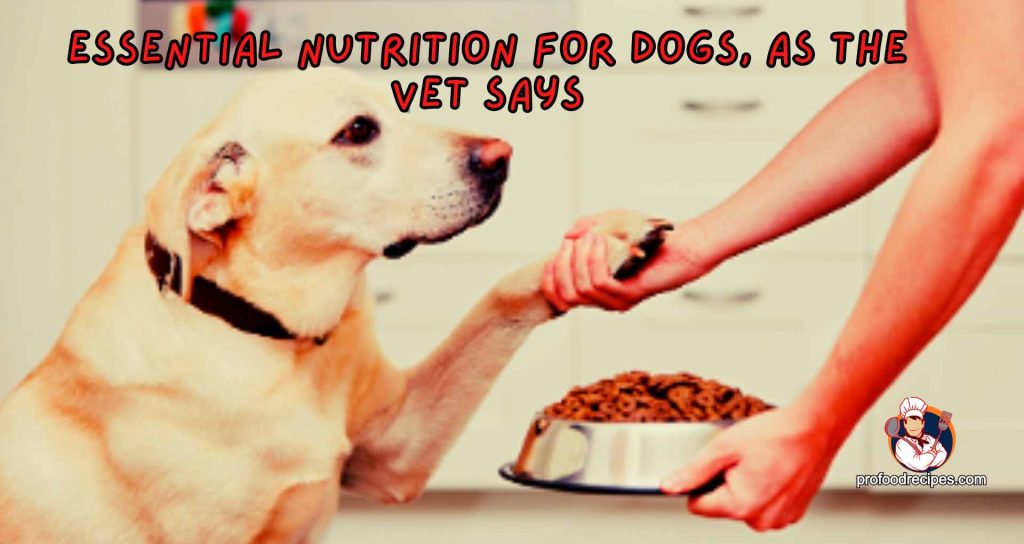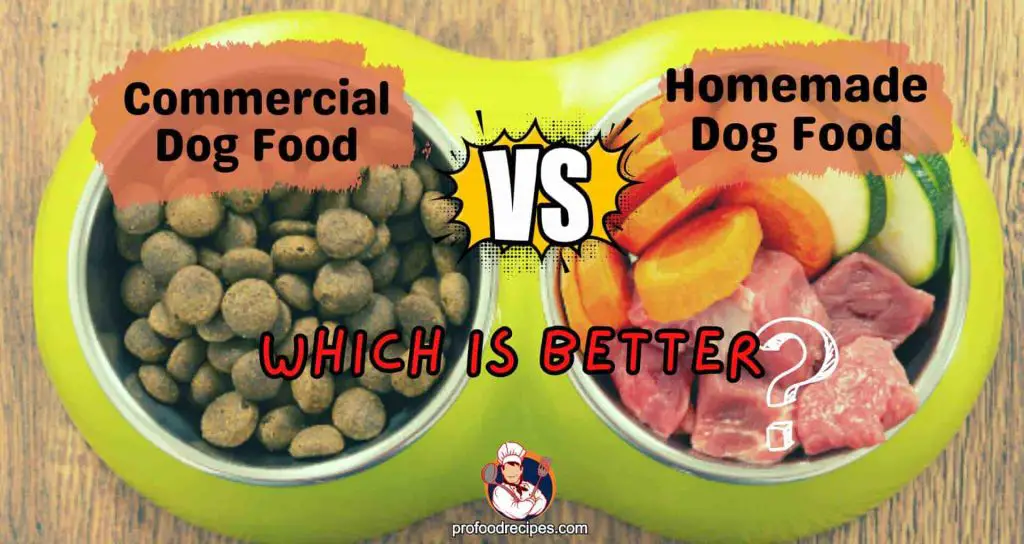Last Updated on December 7, 2022 by Amanda P. Brown
A healthy diet is essential to your dog’s well-being. To achieve this, you must feed your nutritious dog rather than processed food. Many professionals suggest making your dog’s food at home so you can better monitor their nutrition, ensure they get the nutrients they need, and make informed decisions about whether or not to use artificial ingredients.
However, if you’re concerned about your dog’s well-being and want to learn more about how much food they require and what kinds of food are best, you can check out the article below. Here I’ve included some DIY Homemade Dog Food Recipes Vet Approved. With this home-cooked fare, you can ensure they get all the nutrients they need.
Why Homemade Dog Food is Beneficial?
Table of Contents
Making your homemade dog food enables you to produce a superior, complete protein alternative source that also contains fiber, minerals, and vitamins for a balanced diet. Similarly, homemade food does not contain preservatives, so they do not cause allergic, skin, or gastroenterological problems.
In addition, fresh ingredients are added to their food in consideration of their health, which keeps them healthy with long shelf life, boosts immunity, and helps to keep the immune system strong.
What Should Be the Main Ingredient in Homemade Dog Food?

A well-balanced home-cooked meal should have fiber, protein, and carbohydrates. Adults only need approximately 18% protein in their diets, whereas puppies need about 25%. However, your dog’s protein needs will change depending on age and breed, so it’s important to see your vet to determine the exact quantity.
Since each dog’s dietary requirements vary based on its age, size, and breed, so for this, you have to keep homemade dog food as the main ingredient – Your pet requires protein from animal sources, carbs (vegetables or grains), and fat from sources like meat or oil.
They also require calcium (from dairy products or an ingredient like egg shells), vital fatty acids, and magnesium (from certain plant egg yolks, oatmeal, oils, and other foods).
DIY Homemade Dog Food Recipes Vet Approved

Following are some of the vet-approved dog food recipes, along with nutritional information.
1. Brown Rice and Turkey with Rosemary Dog Food Recipe
This recipe is an excellent source of healthy carbohydrates, vegetables, and fat-free animal proteins. It yields 12 cups of wholesome dog food, which you can keep in the fridge for up to 5 days. And this recipe just takes 30 minutes to prepare and serve.
Ingredients
- Ground Turkey: 1 pound
- Dried Rosemary: 1tbs
- Water: 6 cups
- Brown Rice: 2 cups
- Frozen Vegetables package like(carrots, cauliflower and broccoli): 1/2 (16 ounce)
Directions
- Place rice, ground turkey, rosemary, and water in a big Dutch oven.
- Now stir until the ground turkey is beaten so that it is consistently distributed to all mixtures.
- Boil and reduce the heat, and cook for 20 minutes on a little heat.
- Then cook for another 5 minutes after adding the frozen vegetables.
- Finally, remove it from heat, let it cool, and store it in the refrigerator until used.
Nutritional Facts (Per Serving)
| Per Serving | Amount |
| Fat | 4.3g |
| Carbs | 4.7g |
| Protein | 11g |
| Calories | 97 |
| Minerals and vitamins | Iron; and Potassium |
2. CBD-Infused Dog Treats
CBD is an excellent accumulation to your dog’s holistic medication regimen. This CBD is also great for treating your dog’s seizures, pain in dogs with cancer or arthritis, inflammatory problems, noise phobia, or separation anxiety in dogs.
However, you can also add it in moderation to your dog’s diet, which is excellent for maintaining physical balance.
Ingredients
- Gluten-Free Flour: 2 ½ cups
- Oats: ½ cups
- Pumpkin puree (Pumpkin pie without filling): 1 cup
- Apple( grated and cored): 1
- Coconut Sugar:1tbs
- Peanut Butter: ½ cup
- Beaten egg: 1
- Coconut/olive oil: 1/3 cup
- Water: ½ cup
- Dash of sea salt
- CBD oil: 120mg
Directions
- First, preheat the oven to 350 degrees Fahrenheit.
- After peeling, grate the carrots and core, and grate the apple.
- Take a medium-sized bowl and add oats, coconut sugar, and gluten-free flour. Take another bowl and add an egg, beat it well, then add grated carrot, apple, coconut oil, and enough water.
- Mix the bowl of two ingredients well, add CBD oil, and remix it.
- Divide the dog biscuits into the dog treat baking pan using a tablespoon measuring spoon.
- Now bake the biscuit for at least 32 to 37 minutes or until the outside is golden brown and firm.
- You need to store it in an airtight container.
3. Slow Cooker Beef and Rice Meal
This recipe contains protein-rich beef, brown rice, and healthy vegetables for a great treat for your dog. This dish makes up to 12 cups (88 fluid ounces), and you can store this beef stew in the refrigerator for the next day.
Ingredients
- Ground Beef: 2 ½ pounds
- Uncooked brown rice: 1 ½ cups
- Drained and washed kidney beans: 1 ( 15 ounces)
- Chopped butternut squash: 1 ½ cup
- Diced carrots: 1 ½ cup
- Frozen peas: ½ cup
- Water: 4 cups
Directions
- First, take a slow cooker and add all the ingredients like brown rice, ground beef, butternut squash, kidney beans, peas, and carrots.
- Then add 4 cups of water and stir all the ingredients.
- Cover with a lid and cook for at least 5 to 6 hours on low heat and 2 to 3 hours on high heat.
- When it is cooked, shake all the ingredients well. Keep it at room temperature and cool it.
Nutritional Fact
| Per Serving (1 Cup) | Amount |
| Fat | 7g |
| Protein | 39.1g |
| Carbs | 44.2g |
| Calories | 400 |
| Minerals and Vitamins | Potassium; Calcium; and Iron |
Read More: DIY Homemade Dog Food with Sardines
3 Vet Approved Homemade Dog Food Treats
Recipe 1: (Vet Approved)
In many cases, we are concerned with how much of the same food should be fed based on the dog’s weight to provide a nutritious diet. MSCPA-Angel Animal Medical Center in Massachusetts offers a recipe for dogs of different sizes, such as 15, 30, and 60 pounds, made with the same essential ingredients but in different amounts. So for that, I’ve described below a chart of how much kibble you should give your 15, 30, and 60-pound dog.
Needed
| Key Ingredients | The amount required for a 15-pound dog | The amount required for a 30-pound dog | The amount required for a 60-pound dog |
| Cooked protein sources; (turkey, dark chicken, beef, eggs, or lamb) | 3 ounces | 4.5 ounces | 8 ounces |
| Cooked carbohydrates;( sweet potato, peas, rice, oatmeal or corn, barley) | 1 1/3 cups | 2 cups | 3.5 cups |
| Cooked or uncooked vegetables;(green beans , carrots, baby spinach, broccoli or squash, bell peppers) | 1tbs | 1.5tbs | 3tbs |
| Fat sources like;(vegetable oil) | 1-2 tbs | 2-3tbs | 3-5tbs |
Directions
- Take a bowl and add cooked protein and carbohydrate sources, raw or cooked vegetable sources, and fat in the abovementioned amounts.
- Then let it cook.
- It needs to be cooled and ready to be served.
Recipe 2 (Vet Approved)
This recipe differs slightly from the MSCPA because it is formulated to provide your dog with daily vitamins. Founding Veterinary Clinic (FVC) of Brea, Calif., uses bonemeal powder or calcium citrate in this recipe to compensate for calcium deficiency, bony fish as a protein source, and potatoes as carbohydrates.
So below is the recipe with a chart of the FVC approved that applies to a 20-pound dog. But you can offer half if your dog is 10 pounds and double if it’s 40 pounds.
Needed
| Key Ingredients | The amount required for dogs of(20lb) | The amount required to halve for dogs of(10lb) | The amount required to double for dogs of(40lb) |
| Cooked skinless chicken | ¼ pound | ½ pound | 1/8 pound |
| Brown rice | 1 cup | ½ cup | 2 cup |
| Vegetable oil | 1tbs | ½ tbs | 2tbs |
| Carrots and peas | 1 cup | ½ cup | 2 cup |
| Salt substitute of a (Potassium chloride) | 1/4tbs | 1/2 tbs | 1/8tbs |
Directions
- Heat a pot on a low flame with enough oil.
- Then brown rice, cooked skinless chicken, carrot, peas, and enough oil must be mixed and allowed to cook.
- After cooking, it should be allowed to cool.
- To be served.
Read More: Weight Gain Dog Food Recipes
Essential Nutrition for Dogs, as the Vet Says

You should feed dogs a balanced pure kibble diet which is essential for their nutrition. A complete nutritional diet supports your dog’s growth, cell maintenance, gastrointestinal protection, and performance. However, due to differences in the ages of dogs, their nutritional needs are also quite different.
The vet says that an adult dog’s daily meal should have 2.5 to 4.5% fiber to retain up to 50% of its body weight in carbohydrates. Diet should make up at least 5.5% of the diet, and protein should make up 10%.
Also, experts recommend that as part of their dog’s nutritious daily diet, basic elements such as carbohydrates, proteins, vitamins, fats, minerals, and water are involved in healthy function.
How much homemade dog food should I feed my dog?
How much homemade dog food to feed your dog depends entirely on your dog’s age, needs, activity level, and breed. Generally, dogs need to consume 2 to 3 percent of their ideal body weight per day. Larger breeds may require as little as 1 1/2 percent, while smaller breeds may require up to 4 percent.
Moreover, to give you clear information, I’ve provided a chart below so that you can look at it before feeding your dog.
| Dogs Weight (LBS) | Less Active (Cups ) | Active (Cups) |
| 1 to 10 | ¼ to ½ | ¼ to ¾ |
| 11 to 20 | ½ to 11/4 | ¾ to 11/2 |
| 21 to 30 | 11/4 to 11/2 | 11/2 to 2 |
| 31 to 40 | 11/2 to 13/4 | 2 to 21/4 |
| 41 to 50 | 13/4 to 21/4 | 21/4 to 23/4 |
| 51 to 70 | 21/4 to 23/4 | 23/4 to 31/2 |
| 71 to 90 | 23/4 to 31/2 | 31/2 to 41/4 |
Commercial Dog Food Vs. Homemade Dog Food: Which is Better?

How each dog reacts to store-bought or home-cooked food is the most important factor in determining which is preferable. The ideal food source for a dog will vary depending on its demands, age, size, level of activity, etc. Each dog has a diverse nutritional profile because they have varying physical exercise capacities.
Additionally, you intend to offer them fresh, high-quality homemade dog food. But doing this takes time and patience. And many folks offer commercial food to avoid these issues. Both would benefit your dog greatly, but it depends on which one he can handle.
To help you decide which option is best for your dog, I’ve weighed the benefits of commercially available dog food and homemade dog food, considering your dog’s specific age, size, breed, and dietary preferences.
Commercial Dog Food Pros
- Specialty brands of commercial dog food offer expertly formulated diets based on the dog’s weight, age, and health.
- This food contains moderate amounts of all the essential vitamins, minerals, and fiber that are good for your dog’s diet.
- Commercial dog food is readily available, so you don’t have to worry about preparing dog food while traveling or commuting anywhere, which is a great alternative to your busy shopping days.
Commercial Dog Food Cons
- Preservatives are often added to commercially produced dog food to preserve it for long periods, which is harmful to them.
- These dog foods are made with certain ingredients, such as milk and nuts, that can cause allergies and stomach problems in dogs that are not allowed to be picked at the time of purchase.
- Some low-quality commercial foods often contain meat by-products instead of wholesome meat.
- Commercial foods are often loaded with high levels of vitamins and other ingredients that put dogs at risk of kidney failure and even death.
- Several research has shown that commercial dog food has the potential to be contaminated with bacteria that can be dangerous to the dog’s health if it comes into contact with the dog food.
Homemade Dog Food Pros
- When making homemade dog food, you are aware of your dog’s overall health, and it is formulated with all the nutrients they need to stay healthy.
- Homemade dog food is made with whole fresh ingredients that benefit their health.
- The nutritional quality of homemade dog food remains intact.
- Homemade dog food does not contain preservatives or harmful chemicals.
- Homemade foods avoid ingredients that can cause a dog to suffer from allergies, kidney damage, or other health problems. This food is a great one for your dog’s health-conscious diet.
Homemade Dog Food Cons
- Many experts advise against feeding homemade dog food because it may not contain the necessary nutrients, is contaminated with bacteria, and has not been tested by a nutritionist.
- Preparing this homemade food for your busy day is time-consuming and cumbersome. You may not have all the necessary ingredients when traveling or on the go, which can lead to nutritional disruption for your dog.
- Homemade food does not have any specific levels added to it.
- Many experts believe that homemade dog food lacks the necessary supplements and supplies of vitamins and minerals.
Every dog, though, has its quirks. Considering that a serving of excellent food for one dog may not be suitable for another. Therefore, it’s crucial to put your dog’s health first when deciding whether to feed them commercial or homemade dog food to improve their well-being.
Additionally, it is best to always get the advice of a nutritionist or other pet professional before making any dietary modifications for your dog.
Do Dogs Live Longer With Homemade Dog Food?
Yes, homemade dog food makes dogs live longer because you can give your dog a complete meal composed of good fats, vitamins, minerals, and carbs by using homemade food. Also, homemade food is ideal if your dog has gastrointestinal sensitivities, allergies, or skin issues because you’ll be ready for their nutritional and medical needs.
However, according to statistical methodologies, dogs had an average longevity of 10.4 years when given industrially processed food. In contrast, dogs lived an average of 13.1 years when fed homemade food.
Final Verdict
Cooking your dog’s food from home is simple, and it will be better for them because the nutrients will preserve. A dog just needs a moderate amount of essential nutrients to stay in excellent health. I’ve compiled the top DIY Homemade Dog Food Recipes Vet Approved above to help you provide them with a healthier diet. These meals are simple to create at home and provide your dog with the best nutrients possible.
It is best to take your dog to the vet before making any modifications to your dog’s diet, including making homemade dog food, to be sure you’re providing them with the greatest possible nutrition.
You May Also Like to Read:
- Can an Adult Dog Eat Puppy Food?
- Can Dogs Eat Zucchini?
- Rottweiler Vegetables: What Vegetables Are Good for Rottweilers?
- How Much Should a German Shepherd Eat a Day?
- 15-Healthy Vegetables for German Shepherd
- What Can German Shepherds Not Eat?
- What Foods Are German Shepherds Allergic to?

